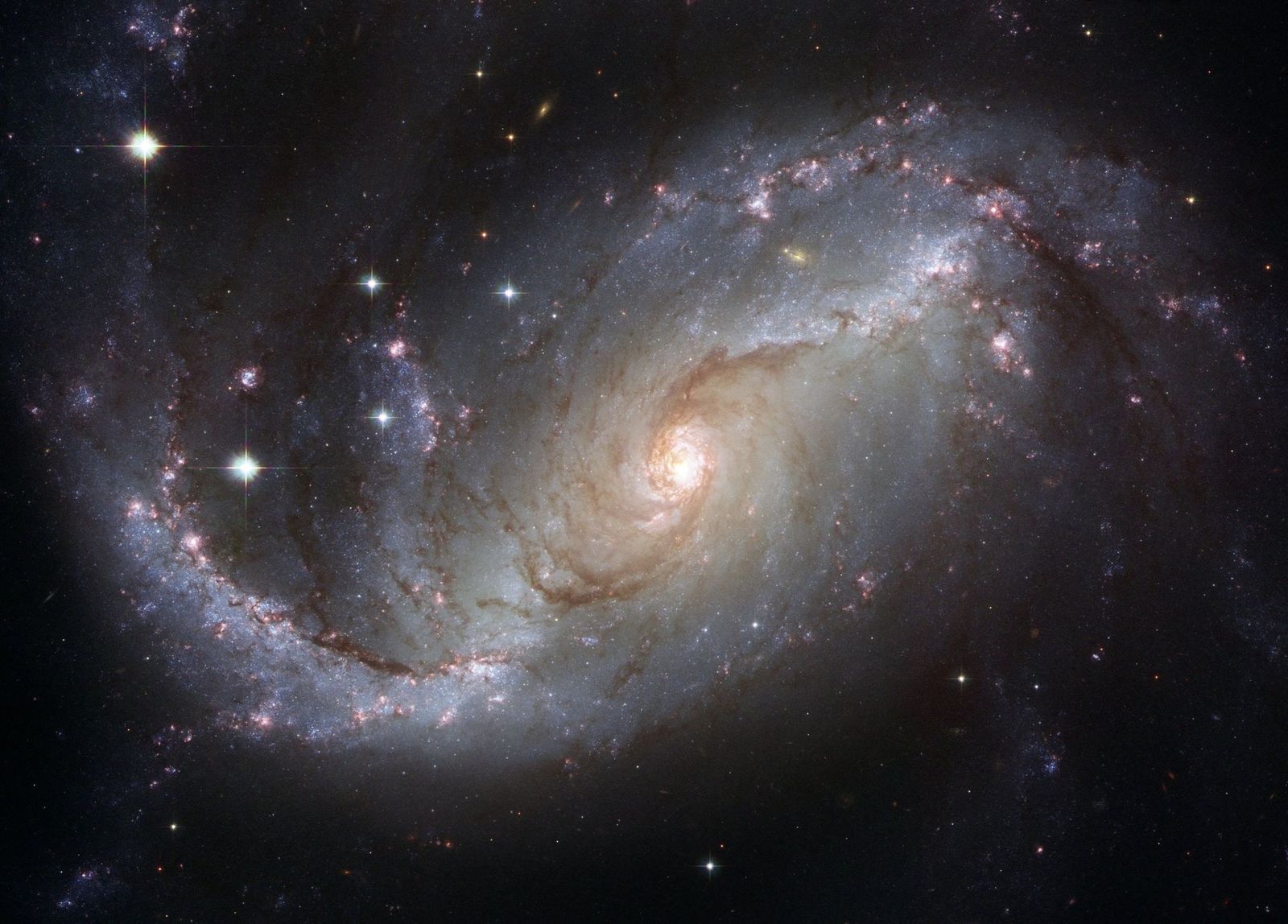MOND an Introduction
warning
This article is one among many salvaged from my previous blog! It is not on par with my demands of quality but I didn’t feel like abandoning it.
On Dark Matter

Consider a stone fastened to rope. Imagine you are holding the rope in the other end. Now, start rotating with it, but slowly. What do you notice? The stone drags itself along the path on the ground. Now make the rotation faster, the stone starts to levitate in your reference frame.
Now this levitation can be taken to be as stability of rotational motion. A lesson here is that we need sufficient tangential force for stability in the rotational motion. Now enough physicising with small objects. Let’s move to something big. Let us take a galaxy for example.

Here, the stars and planets are moving around a huge massive black hole in the centre of the galaxy. Let us write down Newton’s Gravitational Law for such a system.
$$ F_{\text {grav }}=G_{\text {newt }} \frac{m_b m_s}{r_{b s}^2} $$
where $ F_{\text {grav }} $ is the gravitational force between the black hole and the star, $ G_{\text {newt }} $ is the Newtonian gravitational constant, $ m_b $ is the mass of black-hole, $m_s $ is the mass of the star under study, $r_{b s} $ is the distance between the black-hole(or centre of the galaxy) and the star under study.
The mass of the black hole and the star is computable using other experimental methods which we shall not discuss here. The distance is computable by using some trigonometry and we are aware of the Newtonian Gravitational constant. Hence, we can compute the gravitational force acting on our star.
Interestingly, the force value thus computed is far lower than the required force to keep the trajectory of the stars stable. But observations prove that the stars are moving in the rotational motion in a stable manner. So, what did we get wrong?
Physicists proposed that there is a hidden mass that doesn’t emit light which contributes to the extra gravitational force necessary for the stability of the stars moving around the galaxy. Mathematically, we have the following:
$$ F_{\text {neces }}=F_{\text {grav }}+F_{\text {dm }} $$
where $F_{\text {neces }}$ is the necessary force for the stable orbit of stars moving in the galaxy, $F_{\text {grav }}$ is the gravitational force due to the gravity generated by the mass of black hole and the star under the study, $F_{\text {dm }}$ is the gravitational force generated by the mass of dark matter and the star. So, we can write(with some caveats):
$$ F_{\mathrm{dm}}=G_{\text {newt }} \frac{m_{d m} m_s}{r_{b s}^2} $$
which, when using the above relations, we obtain this information:
$$ m_{d m}=\left(\frac{r_{b s}^2}{G_{\text {newt }} m_s}\right)\left(F_{\text {neces }}-F_{\text {grav }}\right) $$
Now, $ F_{\text {neces }}$ is just the centripetal force on the star, hence, we can write the following:
$$ F_{\text {neces }}=\frac{m_s v_s^2}{r_{b s}} $$
where $v_s$ is the tangential velocity of the star along the trajectory it is moving on. Substituting for $ F_{\text {neces }} $ and $ F_{\text {grav }} $, we obtain:
$$ m_{d m}=\frac{r_{b s} v_s^2}{G_{\text {newt }}}-m_b $$
By PhilHibbs - Own work in Inkscape 0.42, Public Domain
The above is the velocity curve with A being the predicted from our equations theoretically(the one without dark matter) and B being the actual one observed. This is called the velocity dispersion curve or galaxy rotation curve. The B curve and a curve generated by utilizing the dark matter, fit very closely. However …
To explain the origin of this mass, we have hundreds of mathematical models derived from particle physics with not much experimental verification. We have been hunting for a theory of dark matter for more than 5 decades and we still haven’t settled on one with a satisfying experimental validity. This made a few physicists think that we might be missing something. But before we discuss this missing piece of the puzzle, we have clearly used Newtonian gravity to explain this scenario. What about Einstein’s General Relativity? Surely, it is a more accurate theory of gravity and it might have something special for us in the store, right? Well, not, let’s look at why that is so.
Einstein’s Theory of Relativity: A Calibration Step
I feel the derivation of Einstein’s Field Equations in General Relativity a bit ad-hoc. Let me explain how it is derived. Let us first, discuss the equation itself.
$$ A_{\mu \nu}=\kappa T_{\mu \nu} $$
We are not including the cosmological constant for now. With that stated, $A_{\mu \nu} $ is the ******** tensor, $\kappa $ s the constant or proportionality and $T_{\mu \nu} $ is the stress-energy tensor of spacetime.
If we follow the logical deductions of Einstein, we see that some tensor describing the spacetime must be proportional to the stress-energy tensor. This conclusion springs after a series of logical reasoning from the insights derived from Einstein’s gedankenexperiment or thought experiment of the man trapped inside a lift which is placed in a gravitational field in one scenario and the lift being given the acceleration in another scenario. Here, Einstein establishes the proportionality we stated above.
Now, one peculiar property of the stress-energy tensor is as follows:
$$ \partial_\mu T^{\mu \nu}=0 $$
The above equation dictates the energy-momentum conservation of the system. That demands us the following,
$$ \partial_\mu A^{\mu \nu}=0 $$
due to our equality. The tensors which purely contain the information of the curvatures of spacetime are as follows:
$$ g_{\mu \nu} \text { and } R_{\mu \nu \sigma}^\rho $$
where $g_{\mu \nu}$ is the metric tensor and $R_{\mu \nu \sigma}^\rho$ is the Riemann tensor. These two were the candidates for the definition of $A^{\mu \nu}$. A naive or rushed move would be to substitute these candidates directly to $A^{\mu \nu}$ and check the validity by testing $\partial_\mu A^{\mu \nu}=0$.
Unfortunately, both of them fail. With some series of permutations and combinations, Einstein defined a new tensor called Einstein tensor(of course the name came later and was named by somebody else). The Einstein tensor is defined as: $$ G_{\mu \nu}=R_{\mu \nu}-\frac{1}{2} R g_{\mu \nu} $$
where $R_{\mu \nu}$ is the Ricci curvature tensor, which is in fact a contraction of the Riemann Tensor written as $R_{\mu \nu}=R_{\mu \rho \nu}^\rho$ and $R$ is the Ricci scalar which is yet another contraction of the Ricci curvature tensor.
It is worth mentioning that only after a deliberate attempt to figure this $G_{\mu \nu}$ which satisfies $\partial_\mu G^{\mu \nu}=0$ did Einstein moved forward in writing down his gravitational field equation as follows: $$ G_{\mu \nu}=\kappa T_{\mu \nu} $$ Now before we figure out what is $\kappa$, we must make a point of why we missed the cosmological constant which is written down in Einstein’s equation. It is because Einstein himself found it ad-hoc to plug the Einstein tensor with a Ricci scalar and he wished what if there were another scalar quantity that can exist in this field equation. An attempt to this and experimental data supported the existence of the cosmological constant $\Lambda$ which makes the field equation read as follows: $$ G_{\mu \nu}+\Lambda g_{\mu \nu}=\kappa T_{\mu \nu} $$
But, more on that in a future article. Coming back to our discussion, we see that we have to figure out the constant $\kappa$ yet and let us do so. Here, Einstein took a limiting approximation of Gravity being weak, albeit the curvature is minimal. And working out a series of steps, he ended up with some equations where he plugged in Newton’s Gravitational Force formula! Doing so yields us with the following: $$ \kappa=\frac{8 \pi G_{\text {newt }}}{c^4} $$ Plugging this into the Einstein’s Field Equations, we obtain the following: $$ G_{\mu \nu}=\frac{8 \pi G_{\text {newt }}}{c^4} T_{\mu \nu} $$
This means that the heart of Einstein’s General Relativity still recovers the Newtonain Gravity for weak cases. This makes for the fact that the above rudimentary analysis for Dark Matter is sufficient and an attempt to utilize the Einstein’s Field Equations will still deliver us the same result, albeit we have to cross the amazon of the complicated algebra of Tensors.
MOND: Basics
Now, some physicists thought that what if Newtonian Gravity is not the exact explanation of the gravity in the limit of the galaxy cluster i.e, for minute acceleration and velocities in the scale of a galaxy. The logical conclusions to make when one sees the deficiency in the galaxy rotation curves are as follows:
- There exists in galaxies large quantities of unseen matter which boosts the stars’ velocities beyond what would be expected on the basis of the visible mass alone, or
- Newton’s Laws do not apply to galaxies.
The first inference lead us to Dark Matter theories, the second to MOND. Thus came the framework MOND: Modified Newtonian Dynamics.
It is proposed by Mordehai Milgrom in 1983. MOND basically rewrites the force law given by Newton for gravity as follows:
$$ F_N=m \mu\left(\frac{a}{a_0}\right) $$
with $\mu$ being the interpolating function with the properties follows:
$$ \mu(x)= \begin{cases}1 & \text { for } x \gg 1 \ x & \text { for } x \ll 1\end{cases} $$
Two such interpolating functions can be written as follows: $$ \mu\left(\frac{a}{a_0}\right)=\frac{1}{1+\frac{a_0}{a}} \text { and } \mu\left(\frac{a}{a_0}\right)=\sqrt{\frac{1}{1+\left(\frac{a_0}{a}\right)^2}} $$ MOND can be interpreted in two ways, one way is to modify the Newton’s Force law which gives us the modified equation for centripetal force for a star in the MOND regime as: $$ \frac{G M m}{r^2}=m \frac{\left(\frac{v^2}{r}\right)^2}{a_0} \quad \Longrightarrow \quad v^4=G M a_0 $$ or modifying the Gravitational Force of Newton by keeping the second law of Newton intact as follows:
$$ \frac{G M m}{\mu\left(\frac{a}{a_0}\right) r^2} $$
Now, this hypothesis that we need a modification of Newton’s Law fits well with the observation of the galaxy rotation curves. That is a great leap of success for we don’t need strange matter to explain such curves.
MOND: Compatibility
Here is a list of other areas where the MOND framework is successful in explaining the observational data where it is hard to do so with dark-matter models. The list is not very extensive here, but for a extensive one, refer here.
- Since MOND modifies Newtonian dynamics in an acceleration-dependent way, it predicts a specific relationship between the acceleration of a star at any radius from the centre of a galaxy and the amount of unseen (dark matter) mass within that radius that would be inferred in a Newtonian analysis. This is known as the mass discrepancy-acceleration relation and has been measured in observations.
- Recent work has shown that many of the dwarf galaxies around the Milky Way and Andromeda are located preferentially in a single plane and have correlated motions. This suggests that they may have formed during a close encounter with another galaxy and hence be Tidal Dwarf Galaxies. If so, the presence of mass discrepancies in these systems constitutes further evidence for MOND.
- etcetera
Quantum Gravity and Recent Developments
A theory of quantum gravity is expected to contain MOND framework by default in itself for some special limiting factors for MOND to be true. A major pressing issue of MOND is it’s absence of a equally successful Relativistic Formulation. We hope we get a relativistic formulation which can explain more phenomena than the dark-matter models we have around us. Current models fall short of explaining CMBR anisotropy and other critical phenomena. Perhaps a hybrid dark-matter-MOND model might answer more answers!